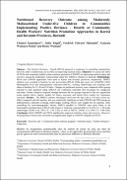| dc.description.abstract | The Positive Deviance - Hearth (PD-H) approach is important in controlling malnutrition; however, there is limited data on its effect in improving nutrition status. Objective: To assess the effect of PD-H and community health worker nutrition promotion (CHWNP) in improving nutrition status and recovery among the moderately malnourished under-five (MMU5) children in Burundi. Methodology: PD-H and CHWNP approaches were used in Karusi and Kirundo provinces, respectively. MMU5 children were enrolled at baseline for the intervention (PD-H, (358) and usual care (CHWNP, (310). Haemoglobin level and anthropometric indicators (MUAC, wasting, underweight and stunting) were taken at baseline for 12, 60 and 120 days. Changes in nutritional recovery were compared within groups exposed to each approach using ANOVA for continuous outcomes and chi-square for categorical outcomes. Further analysis compared changes between the two groups exposed to the two approaches using random effects logistic models for binary outcomes and mixed effect models for continuous outcomes. Results: The MMU5 children discharged cured after 60 days and at 120 days follow-up. When compared with the baseline, this was statistically significant in both CHWNP and PDH groups on anthropometric indicators (wasting, underweight, stunting, MUAC and weight) but not anaemia. After controlling for socio-demographic factors, MMU5 enrolled in CHWNP were more likely to be discharged cured than those in PD-H with respect to moderate wasting (AOR=2.74, 95% CI= 1.19-6.29), underweight (AOR=1.56, 95% CI= 1.01-2.43) as well as MUAC (AOR=1.21, 95% CI= 0.49-3.00). Conclusion: Both CHWNP and PD-H significantly improved nutrition status and recovery. However, the proportion of those who recovered was significantly larger in CHWNP compared to PD-H. | en_US |



